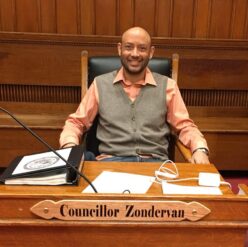Councillor Zondervan recently joined his colleagues in submitting amendments to the proposed Affordable Housing Overlay. You can find them below, along with jump-links to a red-lined version of the proposed language. Please reach out to let him know what you think by emailing <[email protected]>, or just by leaving a comment on this post!
Introduction
With nearly 20,000 individuals and families on the housing waitlist, it is frustrating to have spent most of the term and so much energy on a proposal that the city claims will lead to a few hundred additional units (at best) over the next decade, beyond what would have otherwise been built. Nobody disagrees that our zoning code could use a citywide overhaul, and the conclusion of the Envision master plan process seems to be a great time to do it. But this proposal takes a very narrow lens to that task, and for all the controversy, it seems likely that it will not meaningfully address the problem at hand.
Ultimately, we will need to be much bolder in our approach if we truly want to make a difference. Nonetheless, the AHO is before us and it is our duty as a council to carefully weigh the costs and benefits and to improve it as best we can before finally making a decision. I have listened to the perspectives of hundreds of constituents on this issue, and I have taken the time to seek out voices we don’t often hear from. A few themes have emerged from these conversations, which I have done my best to capture in the attached amendments for your consideration.
In order for me to support an as-of-right citywide rezoning, there are three critical points I will be considering:
- We must protect existing tenants from displacement, and we must protect our local businesses as well.
- We must build with the climate crisis in mind, and that means anything we build should not be making global warming worse, and should protect the health and safety of its occupants from the impacts of climate change.
- We must be assured that the resulting buildings will be of the highest quality, that they will meet the architectural and design standards that we expect, and that they will serve the needs of the occupants.
This is by no means a final or exhaustive list of changes that will be required, and we are very much still at the beginning of the conversation in terms of evaluating whether or not the AHO is a good idea for Cambridge. The question does not hinge on the severity of the housing affordability crisis, which is high, but on the expected benefits of the policy proposed to address it.
Whether or not we approve the AHO, we still have a lot more work to do in meeting the twin challenges of housing our residents affordably and protecting ourselves from climate change. That is why I am an outspoken supporter of Representative Connolly’s Housing for All agenda, and that is also why I will be introducing a bolder series of reforms this fall, including a ban on fracked gas in new construction and a proposal to allow multifamily housing everywhere in our city.
Summary of Zondervan Amendments
- I was glad to finally receive draft AHO design guidelines from CDD. While these are a good start, a great deal more work remains to be done before these guidelines can be considered an acceptable tradeoff for eliminating discretionary project design review. I look forward to the continuing development of these guidelines.
- Any tenant directly displaced by an AHO construction must be guaranteed a right to return. (definitions, 3.b.iv)
- For AHO units, we should give preference to those who have experienced a no-fault eviction from a market unit within city limits within the past year. (3.b.i)
- AHO construction should not be exempt from the Tree Protection Ordinance. This is a fundamental matter of equity; everyone deserves access to the health and safety benefits of trees in close proximity to their dwelling units. The Affordable Housing Trust Fund should cover any additional costs incurred while achieving these standards, so that compliance won’t limit or prevent affordable housing construction. (7.6)
- AHO buildings must be built Net Zero Ready (definitions), which means: as energy efficient as possible, with no on-site fossil fuel combustion, and maximum on-site solar production (if technically feasible), geothermal or air-source heating & cooling, and rainwater capture. (7.6)
- FAR (density) should be limited to ensure sufficient land area for green open space for residents to enjoy and to protect against the heat and flooding impacts of climate change. (7.6.d)
- Protect existing retail in buildings that are rebuilt/refurbished under the AHO. (4.b.i)
- Allow retail services in any AHO building. (4.b)
- 20% of GFA should be set aside explicitly for homeownership purposes in projects greater than 10 units. We could put these units directly into the city’s Homeownership Resale Pool, so there would be no additional administrative overhead. (3.b.iii)
- Off-street surface parking cannot be counted as part of the 30% minimum open space requirement. (5.2.3.a.i)
- 100% of the required open space shall meet the city’s definition of permeable. (5.2.3.c)
- Waive the minimum lot area per dwelling unit dimensional requirement in table 5-1 to allow multiple dwelling units on a site. (4.a).
- We should completely eliminate parking minimum requirements for AHO construction, with the only exceptions being to provide sufficient accessible parking as well as ample space for pickup and dropoff. Developers would still be allowed to build parking, but they wouldn’t be required to do so. (6.1.a)
